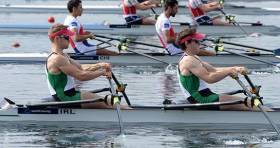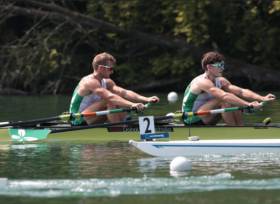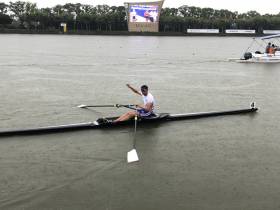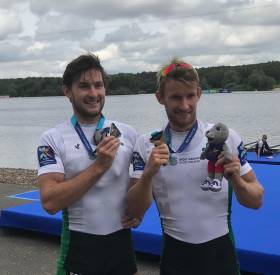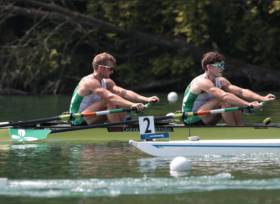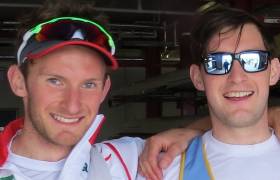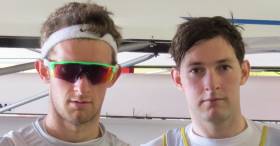Displaying items by tag: Paul O'Donovan
Brilliant Performance Yields World Championship Gold for O'Donovan Brothers
#Rowing: Ireland won gold at the World Rowing Championships with another brilliant row by the O’Donovan brothers. The Ireland lightweight double were in one of the unfavoured lanes - lane six - after taking third in their semi-final. But when it mattered they won.
Italy set off fast, but the O’Donovans chased them down and caught them in coming into the final quarter. They then produced their fastest 500 metres of their race to cross the line first and thrill the roaring crowd.
Italy took second, Belgium third. Before the race, Norway had to replace Kris Brun with Jens Holm.
World Rowing Championships, Plovdiv, Bulgaria, Day Seven (Irish interest):
Men
Lightweight Double Sculls – A Final: 1 Ireland (G O’Donovan, P O’Donovan) 6:06.81, 2 Italy 6:08.31, 3 Belgium 6:11.25.
Women
Pair – A Final: 1 Canada 6:50.67, 2 New Zealand 6:52.96, 3 Spain 7:04.60; 6 Ireland (A Keogh, E Hegarty) 7:15.70.
O'Donovans Qualify for World Championship Final with Third Place
#Rowing: Paul O’Donovan and Gary O’Donovan finished third in their semi-final and qualified for the A Final of the lightweight double sculls at the World Rowing Championships in Plovdiv. Italy were the early leaders and held on even as the O’Donovan brothers produced a good middle third. Coming up to the line, Belgium found a big finish and took second, while Ireland held off Poland to qualify.
World Rowing Championships, Plovdiv, Bulgaria, Day Five (Irish interest)
Men
Pair – Quarter-Final Four (Three to A/B Semi-Finals; rest to C/D Semi-Finals): 1 Canada 6:26.04, 2 New Zealand 6:30.36, 3 Czech Republic 6:35.01; 5 Ireland (M O’Donovan, S O’Driscoll) 6:44.28.
Double Sculls – Repechage Four (First Two to A/B Semi-Final):
Ireland (P Doyle, R Byrne) 6:16.96, 2 Bulgaria 6:20.15.
Lightweight Double – Semi-Final Two (Three to A Final; rest to B Final): 1 Italy 6:21.94, 2 Belgium 6:22.83, 3 Ireland (G O’Donovan, P O’Donovan) 6:23.78.
Women
Pair – Semi-Final (Three to A Final; rest to B Final): 1 Ireland (A Keogh, E Hegarty) 7:14.67, 2 Italy 7:14.99, 3 Spain 7:15.30.
O'Donovans Speed into Quarter-Finals at World Rowing Championships
#Rowing: Ireland’s Paul O’Donovan and Gary O’Donovan won their heat with a sparkling performance at the World Rowing Championships in Plovdiv. Germany’s newly-formed lightweight double of Jonathan Rommelmann and Konstantin Steinhuebel seemed set to give the Ireland crew a test, leading through half way and 1500 metres. But the O’Donovans had much better base speed and left their rivals behind in the final quarter. Portugal and Argentina also qualified for the quarter-finals.
Denise Walsh and Aoife Casey finished fourth in their heat of the lightweight double sculls. The first two positions were the valuable ones, as they secured a place in the semi-finals. New Zealand, Australia and Canada fought it out, with New Zealand’s Zoe McBride and Jackie Kiddle securing a clear first, while Australia edged Canada out by .34 of a second. Walsh and Casey were over 10 seconds further back.
The women’s pair of Aifric Keogh and Emily Hegarty qualified from their heat for the semi-finals, finishing second, while the men’s pair (fifth) and double (second) will have to compete in repechages.
World Rowing Championships, Plovdiv, Bulgaria, Day One (Irish interest)
Men
Pair – Heat Four (First Four to Quarter-Finals; rest to Repechage): 1 Canada 6:20.46, 2 South Africa 6:21.85, 3 France 6:25.43, 4 Belarus 6:28.22; 5 Ireland (M O’Donovan, S O’Driscoll) 6:29.10
Double Sculls – Heat One (Winner to A/B Semi-Final; rest to Repechages): 1 New Zealand 6:02.23; 2 Ireland (P Doyle, R Byrne) 6:12.61
Lightweight Double Sculls – Heat Five (First Four to Quarter-Finals; rest to Repechage): 1 Ireland (G O’Donovan, P O’Donovan) 6:15.79, 2 Germany 6:19.23, 3 Portugal 6:21.55, 4 Argentina 6:30.24.
Women
Pair – Heat One (First Three to A/B Semi-Final; rest to Repechage): 1 New Zealand 6:56.06, 2 Ireland (A Keogh, E Hegarty) 7:11.51, 3 United States 7:13.02.
Lightweight Double Sculls – Heat Three (First Two to A/B Semi-Finals; rest to Repechages): 1 New Zealand 6:50.04, 2 Australia 6:51.11; 4 Ireland (A Casey, D Walsh) 7:02.25.
McKeown's Gold in China Brings Another Reward
#Rowing: The Rower of the Month for August is Sam McKeown. The Queen’s University, Belfast, student won gold in the single sculls final at the World University Rowing Championships in Shanghai. The Portadown man, representing Britain, came in ahead of Chinese and Finnish opponents.
It was another month when Irish rowers were prominent: a young team represented Ireland at the World Junior Championships, while Paul and Gary O’Donovan added a silver medal to their haul as they headed up the Ireland team at the European Championships.
Rower of the Month awards: The judging panel is made up of Liam Gorman, rowing correspondent of The Irish Times and David O'Brien, Editor of Afloat magazine. Monthly awards for achievements during the year will appear on afloat.ie. Keep a monthly eye on progress and watch our 2018 champions list grow.
Paul O'Donovan and Gary O'Donovan Afloat Rowers of the Month
#Rowers of the Month: Paul O’Donovan and Gary O’Donovan are the Afloat Rowers of the Month for July. This may have been the busiest month ever for Irish rowing. There were a string of outstanding performances during a frenetic month at the National Rowing Centre. At the huge Irish Championships, Commercial took their third consecutive senior eights title in a nail-biting race; the Home International saw the Ireland senior men’s team win for the first time this century; the Coupe de la Jeunesse provided a platform for the class of Odhran Donaghy and Nathan Timoney and Aoibhinn Keating and Molly Curry as well as the junior men’s coxed four.
The World Under-23 Championships in Poznan provided rivals for the O’Donovans in terms of July winners. Four Ireland crews reached finals and the lightweight quadruple took silver. David O’Malley and Shane Mulvaney raced to gold in the lightweight pair, a fitting reward for this talented duo.
Sanita Puspure also had a brilliant July. She took silver at the World Cup Regatta in Lucerne, just a few feet away from catching the World Champion, Jeannine Gmelin.
But one Ireland crew took gold at the Rotsee. Gary and Paul O’Donovan had started the month by reaching the final of the Double Sculls on their first competitive visit to Henley Royal Regatta. In the early days of August they would take a silver medal at the European Championships. But the golden moment came at the lake of the gods, Lucerne. The Skibbereen men are the Afloat Rowers of the Month for July.
Rower of the Month awards: The judging panel is made up of Liam Gorman, rowing correspondent of The Irish Times and David O'Brien, Editor of Afloat magazine. Monthly awards for achievements during the year will appear on afloat.ie. Keep a monthly eye on progress and watch our 2018 champions list grow.
Ireland Name Big Team for World Rowing Championships
#Rowing: Seven Ireland crews have been chosen for the World Rowing Championships in Plovdiv, Bulgaria, from September 9th to 16th. There are four women’s crews, headed by Sanita Puspure in a single scull. Aifric Keogh and Emily Hegarty will compete in a pair and Monika Dukarska and Aileen Crowley in a double. The lightweight double of Aoife Casey and Denise Walsh, which competed at the European Championships, go forward.
European silver medallists Paul and Gary O’Donovan will compete in Bulgaria, while there is a heavyweight double of Ronan Byrne and Philip Doyle, which will be competing together at this level for the first time. The heavyweight pair of Mark O’Donovan and Shane O’Driscoll which finished 11th at the European Championships will compete in Plovdiv.
Another crew may be added to the team this week.
Ireland Team for World Rowing Championships, Plovdiv, Bulgaria, September 9th to 16th:
Men
Pair: M O’Donovan, S O’Driscoll
Double Sculls: Ronan Byrne, Philip Doyle
Lightweight Double Sculls: Gary O’Donovan, Paul O’Donovan
Women
Pair: Aifric Keogh, Emily Hegarty
Double Sculls: Monika Dukarska, Aileen Crowley
Lightweight Double Sculls: Aoife Casey, Denise Walsh
Single Sculls: Sanita Puspure
Other crews may be added
O'Donovans Come out on Top in Tight European Rowing Semi-Final
#Rowing: Paul O’Donovan and Gary O’Donovan won an extremely close semi-final to qualify for the A Final of the lightweight double sculls at the European Rowing Championships in Strathclyde in Scotland this morning.
Poland and the Czech Republic were the leaders to halfway. By 1500 metres, Ireland were in the lead. But Poland, Britain, Belgium and the Czech Republic were within a boat length of them. Belgium provided the best test for the Irish and took second, with Poland pipping Britain – by .22 of a second – for the third and final qualification place.
In the other semi-final, France missed out as Norway took first, Italy second and the Ukraine a surprise third.
European Championships, Day Three, Strathclyde, Scotland (Irish interest)
Men
Pair – B Final (Places 7 to 12): Britain 6:36.77; 5 Ireland (M O’Donovan, S O’Driscoll) 6:44.58.
Lightweight Double Sculls – Semi-Final Two (First Three to A Final; rest to B Final): 1 Ireland (G O’Donovan, P O’Donovan) 6:28.14, 2 Belgium 6:28.68, 3 Poland 6:29.27.
#Rowing: Paul O’Donovan and Gary O’Donovan won their heat of the lightweight double sculls to qualify confidently for the A/B semi-finals at the European Championships in Strathclyde. France, with Pierre Houin in the stroke seat and Thomas Baroukh in the bow, gave Ireland a good race. It was clear by the 1500 metre mark that these two crews were set for the semi-finals, but France would not let Ireland gain a clearwater lead. At 1750 metres the O’Donovans moved from two-thirds of a length to one length, but France stayed nipping at the lead to the line.
European Rowing Championships, Strathclyde, Scotland (Day One, Irish interest)
Men
Pair – Heat Three (First Two to A/B Semi-Finals, rest to Repechage): 1 Belarus 6:37.38, 2 Britain 6:37.76; 4 Ireland (M O’Donovan, S O’Driscoll) 6:48.94.
Lightweight Double Sculls – Heat Three (First Two to A/B Semi-Finals; rest to Repechage): 1 Ireland (G O’Donovan, P O’Donovan) 6:27.99, 2 France 6:29.83.
Women
Lightweight Double Sculls – Heat One (Winner to A Final; rest to Repechage): 1 Poland 7:08.54; 4 Ireland (A Casey, D Walsh) 7:22.02.
Gold for O'Donovans at World Cup Regatta in Lucerne
#Rowing: Paul and Gary O’Donovan took gold at the World Cup Regatta in Lucerne this morning. Denmark and Belgium had good starts, but the Skibbereen men too over the lead after 800 metres. They held it from there, though Belgium pushed right up on them in the final quarter. The O’Donovans held them off to win by .8 of a second.
World Cup Regatta, Lucerne, Day Three (Selected Results; Irish interest)
Men
Pair – B Final (Places 7 to 12): 1 Spain Two 6:40.42; 3 Ireland (M O’Donovan, S O’Driscoll) 6:43.27.
Lightweight Double Sculls – A Final: 1 Ireland (G O’Donovan, P O’Donovan) 6:28.50, 2 Belgium 6:29.30, 3 Denmark 6:32.39.
Women
Pair – B Final: 1 Spain 7:25.23; 4 Ireland (A Keogh, T Hanlon) 7:32.46.
Double – B Final: 1 Czech Republic 7:05.30; 3 Ireland (M Dukarska, A Crowley) 7:06.92.
Good Win for O'Donovans Lifts Them Into A Final at Lucerne
#Rowing: The race was a tight one, but Paul O’Donovan and Gary O’Donovan won their semi-final of the lightweight double sculls to take their place in the A Final tomorrow at the World Cup Regatta in Lucerne.
The Ireland crew took over from early leaders Denmark, who took second, while Canada beat Britain One for the final qualification spot.
World Cup Regatta, Lucerne, Day Two (Irish interest; selected results)
Men
Pair – A/B Semi-Final One (First Three to A Final; rest to B Final): 1 Serbia 6:33.87, 2 Spain 6:36.65, 3 Britain One 6:38.90; 4 Ireland (M O’Donovan, S O’Driscoll) 6:42.02.
D Final (Places 19 to 24): 1 Poland 6:40.95; 5 Ireland (P Boomer, A Harrington) 6:53.83.
Lightweight Double Sculls – A/B Semi-Final One (First Three to A Final; rest to B Final): 1 Ireland (G O’Donovan, P O’Donovan) 6:19.05, 2 Denmark 6:20.03, 3 Canada 6:20.52.
Single Sculls – C Final (Places 13 to 18): 1 Australia 6:58.52, 2 Argentina 6:59.65, 3 Ireland (P Doyle) 7:00.39.
Women
Pair - Repechage (First Two to A Final; rest to B Final): 1 Australia 7:18.62, 2 China One 7:19.86; 4 Ireland (A Keogh, T Hanlon) 7:29.63.
Double – Semi-Final (First Three to A Final; rest to B Final): 1 New Zealand 6:53.91, 2 Canada 6:57.71, 3 Netherlands 6:58.57; 4 Ireland (A Crowley, M Dukarska) 7:06.42.



























